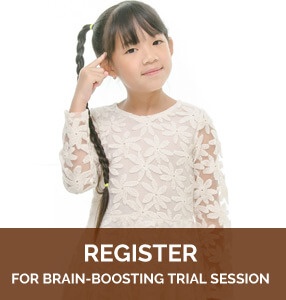Attention is a term (and probably a concern) many parents are familiar with and is something that we always emphasise to our children.
Being able to pay attention in class while learning is very important because if the child is attentive, he will be able to follow what the teacher is teaching, take in all the relevant information necessary to do well and maximise his learning in every situation.
While most parents treat attention as a broad term… the truth is that there are actually different forms of attention abilities our child needs to have in different learning situation and tasks. To help our child get the most out of every learning situation, it is important for us to understand the different forms of attention abilities so that we know how we can help them in different situations.
In this article, I am going to share with you the 4 most critical attention abilities your child should have… and what you can do to help them build up these attention skills.
First of all, let us take a look at the:
4 Forms Of Attention Abilities
- Sustained Attention – The ability to stay on task for the given duration of time. For example, paying full attention for the whole period of English class (for 30 – 60 minutes).
- Selective Attention – The ability to concentrate on any given task without being distracted by stimulus in the environment. An example of this will be completing given worksheet without stopping to talk to the classmate next to him.
- Divided Attention – The ability to complete two separate tasks at the same time (also commonly known as multi-tasking). For example, you might notice that your child has problems copying notes from the board while still listening and understanding what the teacher is teaching all at the same time.
- Auditory Attention – The ability to follow pace of teaching via auditory input. Following and remembering the teacher’s given instructions is the best example of this ability.
It’s important to note that these 4 abilities are not mutually exclusive and instead, they are like the different organs, muscles and systems of our body… working together at times, complementing and supporting each other in the learning process.
However, here’s the thing….
These abilities are present in varying degrees of efficiency within a child.
For example, while a child may be able to sit and work on a piece of worksheet for 30 minutes (strong in sustained attention)… he may find it difficult trying to copy notes in class while still understanding what the teaching is explaining (weak in divided attention).
And in order to help our child maximise their learning, we need to make sure that they are equipped with the different froms of attention skills.
Here’s why…
In the daily classroom, our child is required to tap into different attention abilities for different tasks such as:
– Sounding out, blending and segmenting words when reading, spelling and writing
Learning to read, spell and write with the phonics approach requires the child to be able to hold the parts of the sounds in their mind (auditory attention) while they blend the letters together and try to spell or write out the word (divided attention).
– Listening comprehension
To listen to a story and remember the details of the story requires the child to have strong selective attention so that the child is not distracted while listening to the story. At the same time, a strong auditory attention is needed to ensure the child can follow the story and remember the details correctly.
– Taking a test or exam
A test or exam usually requires the child to work at it and concentrate on the questions over a given period of time, usually an hour or more (sustained attention).
– Follow teacher’s pace of teaching in class
Typically when a teacher explains a concept or topic, she begins to talk continuously as she teaches while at the same time she may write down the key points or steps for the given problem; and she would likely not have the luxury of time to stop and pause at every sentence to ensure the child is following the lesson. Therefore, a child needs to tap into their auditory attention and divided attention abilities to follow the pace of teaching and be able to write down the information correctly.
Attention Skills Determine How Much Our Children Can Learn
From the above tasks, we can easily see that attention skills play a very key role in how well our children learn in the classroom and how much learning they can take in (or may be missing out if are they not equipped with the necessary skills)
Besides facing difficulty with the above tasks, children with weak attention skills may also display some of the following behaviours and/or learning observations:
– Daydreams in the classroom or when doing work
– Difficulty working on a task for a period of time, i.e 30 minutes or more
– Gets restless, fidgety and moves around when doing work
– Looks up at the slightest distraction or sound
– Finds excuses to get away from task (needs to go to the toilet, drink water, take a break, etc)
If you find your child displaying some of the behaviours mentioned above and is concerned about his/her learning ability… fret not.
The good news is that just like any other learning skills, attention abilities can be trained, practiced and improved on… if you have the right strategies.
If you are looking to build up your child’s attention skills…
Here Are Some Interesting Activities You Can Do To Help Them Improve
Activity 1: Work towards a time goal (suitable for young children 3 – 5 years old)
• What to do: Give the child a box of building blocks and have them stack up the blocks in towers of 10 (or 5 for younger children with developing motor skills) and provide them a stopwatch with a given time goal of 3 minutes (for a start). Using a rather easy motor-driven activity, we want to build up the child’s span of attention gradually. Besides attention span, this activity will also practice on fine motor control and focused attention as the child attempts to stack the tower higher.
*Pro tip: Teach the child how to stop/start and read the minutes on the stopwatch. When they are involved, they are likely to be more engaged in the task.
• Level of difficulty: As the child achieves the initial time goal, gradually increase the length of time they need to work on stacking the blocks (remember, the key is gradually because we want the child to experience small successes and build up their confidence and ability progressively). For variety, instead of just towers of 10, they can build the stacks in increasing numbers of 2 (also a good way to introduce maths concepts of timetable) or in a domino pattern (to encourage creativity).
Activity 2: Listening to ‘key words’ in a story (suitable for children aged 6 – 8 years old)
• What to do: Read a short story or passage to the child and have them listen out for a given key word (that you know will appear multiple times in the story—so parents have to read the story beforehand). Usually words like ‘the’, ‘she’ and ‘he’ are likely to pop up quite frequently or names of the main characters are also good key words to choose. As the child listens to the story, they can raise their hand, ring a bell, clap or do a funny dance action every time they hear the key word (this keeps interest high and incorporates the fun element).
• Level of difficulty: Begin with easy key words like the main character’s name and slowly progress to high frequency words that makes the child have to follow the story closely so they don’t miss out anything. Words that appear frequently are harder to catch because we tend to listen to key ideas instead of the small details. However, take note that if the key word will be appearing many times, the accompanying action the child does should be less distractive (i.e instead of a funny dance action, they might just draw a line on a paper to keep track of how many times the key word appeared)
Activity 3: Doing two things at one time (suitable for children aged 9 and above)
• What to do: Have the child build a model, fold an origami, doodle or work at a puzzle. (it is good to set a time goal too) Explain to the child that while they are doing the activity, we will be asking them some simple arithmetic questions and they need to work out the answers while they continue to do the activity.
• Level of difficulty: The objective of this task is to train the child’s ability to do multiple activities with effective mental effort and not about the ability to do challenging arithmetic questions. So, keep to the four operations (plus, minus, multiply, divide) with just single digits. And if the child is having difficulty with multiplication, keep the questions to what they are good at (maybe addition or subtraction). Also keep in mind to ask these ‘distracting’ questions with a good time gap in-between, for example every 15-20 seconds if the time goal is 3 minutes (after the child has answered the previous question). A good way to monitor the progress is to write down the questions you asked and the child’s answers. As they build their divided attention, their accuracy level should improve too.
*Remember, this is not an arithmetic-driven task. So, do not fault the child if they make mistakes in computation.
As we all know, building up any skills requires time, practice and patience.Therefore, as you work these activities with your child… it is important to encourage them for their efforts and provide positive reinforcement to keep them motivated. Start off with an easy goal and gradually stretch their capacity overtime.
Remember: just like any other skills, attention ability can easily be built up and improved on. And once you equip your child with a strong attention ability… he will be able to learn more effecrively and maximise his learning in any situation.
If you are interested to help your child become more focused, more confident and most importantly… able to enjoy learning once again, click here to find out more.







